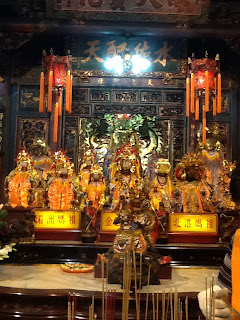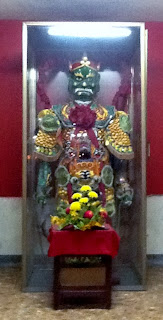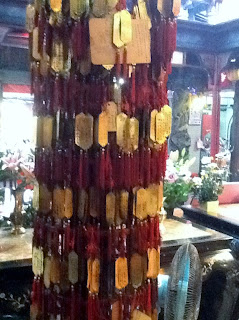Suddenly a loud shriek pierced
the quiet Sunday afternoon at the park. “What’s that?” a woman cries. A huge
flying saucer hovered over the football field; an eerie beam of light came from
the ship’s belly, and the entire U of O football team vanished. Just then Tom
Cruise burst onto the scene to save the day. But then realized it’s U of O… Why
waste his time on saving a team who wears such ugly colored uniforms…
The
City Who Fights Back..
Riding
along in the taxi this afternoon I had an epiphany. I instructed the driver;
using one of my three blah blah phrases I mastered, to take me to Ai Mi, A-Mart
in English. He replied Doy, yes, and we were on our way. The taxi weaved in and
out of traffic with great proficiency and ease; the sad faced buildings stared
back at me through the window. To gain an enhanced comprehension of the driving
skills these taxi drivers possess imagine the heaviest traffic you have ever
witnessed in your life time. Now add 10,000 additional pedestrians, scooters,
busses, taxis, and/or cars. Everywhere you look there are various motorized
vehicles or pedestrians playing chicken with the cars in the crosswalks. This is the traffic in and around the city of
Keelung. When a car honks its horn at you it’s a warning not just meant to make
you aware of its presence, but a warning to remove yourself from its direct
path or be run over. Just about every heavily traveled road in Keelung has crosswalks
and signals which have a digital count down in bright yellow. The countdown
begins its descent at 45. This is 45 seconds during which time pedestrians are
allowed to cross the street. This also gives drivers an idea of when they will
be able to end the wait at the red light and zoom away. However, the crosswalks
really do not hold any type of special value to drivers and the people crossing
in them even less. The traffic turning on the green light is not the only
danger one is forced to struggle against. Imagine a sea of people, cars, and
scooters for these taxi drivers to contend with and then add the stress they
experience from the expectation of prompt delivery of their fare to said destination.
The taxi driving in Taiwan is not just a skill, it’s an art form. Anyone seen
the white rabbit?? Sorry about the trail. During the ride to Ai Mi the taxi
driver would interrupt the deafening silence when he muttered aloud in blah
blah, which probably were curse words. This is the epiphany part, in case you were
wondering if I would be getting to this grand revelation. This city, Keelung,
is wedged in between two separate worlds. There is the “old” world, with
tradition and the old ways of living one’s life. Then there is the “new” world,
which is jostling and jockeying position and new traditions. The taxi driver,
who donned salt n pepper hair, seemed to straddle the two warring worlds with a
simple ease. I only draw attention to the color of the driver’s hair to
illuminate the following. The car this mature fellow was operating was a newer
model Toyota and this ordinary looking taxi boasted modern conveniences not
many American car owners are able to afford. It is no secret Americans over
spend and are notorious for their longing to be noticed for their ability to “keep
up with the Jones’” with no regard to the gravity of consequences. This
competitive streak and the yearning to have the best with no concern for the
cost is the reason Mainland China owns America, lock stock and smoking barrel.
American’s do not deny their desires and other countries have grown to depend
on this well-known fact. Such is the sad commentary on American greed and this
greed is the motivating force behind driving a Lexis you can’t afford, owning a
television with a screen bigger than a small country, and owning hand bags the
price of which would have fed a family of five for an entire month in some
countries. The phrase there is one born every minute springs to mind. The taxi
was equipped with a five disk changer, which also played BlueRay, and viewing
screens for the front and rear passengers. The driver was enjoying what
appeared to be a “Blah Blah” version of “Leave it to Beaver”. I did not enjoy
the reruns of this show when I was a child and this fact was not going to
change based solely on subtitles and the women dressed in what I observed to be
oriental moo moos. Not trying to point out the obvious, but leave it to blah
blah quickly jumped the shark.



My
attention turned to the scenery which seemed to skip past the car at mach 6.
Every now and then we stopped for a red light and this gave opportunity to
truly take in the sights. It has been said there is a 7-11 on every corner in
America. If this is indeed the truth, there are at least two 7-11s on every
block in Keelung. In addition and on the same block, they have a store called
OK Mart, which is similar in kind to 7-11, but way less smelly. We passed
towering modern meccas made of glass and steel. If you looked carefully you
noticed traditional Buddhist temples huddled between the buildings. This affords
the temples refuge from the surrounding environment and to take advantage of
affluences the businesses provide daily. Quick food, as it is termed here,
restaurants can be seen every place you turn. It is in this regard one can
witness the stark juxtaposition between the old and new worlds. Quick food is
beginning to take a position of prominence over the traditional foods cooked at
home. Homemade family dinners are giving way to speed and convenience. Why
would a working mother want to cook when she can have it delivered in 30
minutes or less, guaranteed? The correct answer here, in case you’re slow, is
she wouldn’t want to cook. She is busy and has three children. She cleans the
house, washes the clothes for five people, and listens to her husband complain incessantly.
What makes you think cooking dinner is a priority after the type of day she survived.
KFC, Pizza Hut, and Mc Donalds are an everyday
sojourn for many people with the intention of snatching a bite on the run. Examples
of the war being waged between the two worlds are everywhere one choose to take
in a different aspect. The supermarkets sell traditional Chinese food
ingredients in one isle and around the corner is the freezer section are the heat
and eat “Real Italian Style” pizzas. You can always deifier how “traditional”
the ingredients are by how insulting their odor is to your senses. The further
down the traditional path one chooses to the skip the worse the smell. I do not
even have the fortitude to stand at the trail head and gaze down the path. I
happen to like my Sketchers very much and they would not be cute vomit colored.
I will save the humorous “Real Italian Style” explanation for another blog. It
seems like ease and convenience of the new world is moving in on the old world
and is threatening to snuff it out of existence. The new world offers paperless
maps that give you directions to anywhere you want to travel, although
sometimes flawed and can cause death if one forgoes the use of common sense.
The paperless map mounts to the dashboard and a sultry voice tells you bbllaahh
bbllaahh. The new world way is better than the old method of getting around,
plus a paper map could never make you feel wanted and loved. However, the paper
map could double as toilet paper if you were lost and in need. GPS units, bloothtooth headsets, IPhones, and IPods
(complete with stand and radio connecter) can be found in every taxi cab. Most
taxis also have some type of entertainment system providing the passengers
entertainment and a distraction as the taxi driver takes their lives into his
hands. Every taxi also sports the very traditional in origin religious statue/icon,
prayer contrivance, good luck charm, and device, usually a chain and pendant, used
for keeping ancestors happy and the ghosts far away. The two worlds are
constantly warring for alpha status.
Jing-Xi’s Thought of the Day:
Changing some parts of what one calls tradition can be beneficial. The parts of
tradition which are not helpful or do not hold special value should be changed,
thusly making the traditional acts retain true worth. The parts of tradition
one does because it has always been should be evaluated and eradicated if found
lacking in lesson. If one dances around the bonfire naked during winter solstice
because it has always been, the tradition is sorely in need of evaluation. In
Taiwan tradition is ever important, but some have forgotten why the tradition
is kept and held in high regard. In addition some have lost the old ways
altogether and replaced them with new ways. These new ways are permeating every
aspect of culture and have trickled down into the educational system. The
schools are teaching the students how to order combo meals correctly. The
schools push this new way on the students so much they even teach what is
called “The Fast Food Song”. I am sure there is a valuable lesson Taiwan should
learn from America’s example. Childhood obesity is at an all-time high, but
hasn’t affected these children. Yet..
 This is one of the games the children play. It is a type of fishing game. There are live fish in the orange tub. They have little fish of every color, crabs, and crawfish. They use the net you see and scoop the animals and put them into a holding container floating in the water. When the container is full they dump the contents and begin fishing again. This game does seem a little inhumane, but the children are very careful not to hurt the creatures in the tub. The orange tubs also have a constant flow of water in and out to ensure they live long enough to caught and terrorized by as many children as possible.
This is one of the games the children play. It is a type of fishing game. There are live fish in the orange tub. They have little fish of every color, crabs, and crawfish. They use the net you see and scoop the animals and put them into a holding container floating in the water. When the container is full they dump the contents and begin fishing again. This game does seem a little inhumane, but the children are very careful not to hurt the creatures in the tub. The orange tubs also have a constant flow of water in and out to ensure they live long enough to caught and terrorized by as many children as possible.  Upon first glance you're not sure what these really are. But when you inspect them closly you realize they are duck heads and necks. People eat these horrible looking items wih rice or noodles. They clean the meat off the bones and save the most delicious parts for last, the eyes.
Upon first glance you're not sure what these really are. But when you inspect them closly you realize they are duck heads and necks. People eat these horrible looking items wih rice or noodles. They clean the meat off the bones and save the most delicious parts for last, the eyes.  These are, for lack of a better way to describe them, rotten eggs. They are not really rotten, but it is hard to explain how they prepare these for human consumption. They are some how aged and fit for humans to eat. However, those reading this know I would never let one of these vile looking items any where near my mouth, let alone actually take a taste.
These are, for lack of a better way to describe them, rotten eggs. They are not really rotten, but it is hard to explain how they prepare these for human consumption. They are some how aged and fit for humans to eat. However, those reading this know I would never let one of these vile looking items any where near my mouth, let alone actually take a taste.  These are plates of dired sea creatures, mostly shrimp in variying sizes. They are covered in plastic to keep the bugs out of the product. These are used in cooking and they add them to soups. I did see some people walking around eating these items out of a paper cup. The smell of the seafood is enough to gag a maggot and we all know what they eat...
These are plates of dired sea creatures, mostly shrimp in variying sizes. They are covered in plastic to keep the bugs out of the product. These are used in cooking and they add them to soups. I did see some people walking around eating these items out of a paper cup. The smell of the seafood is enough to gag a maggot and we all know what they eat... 












































